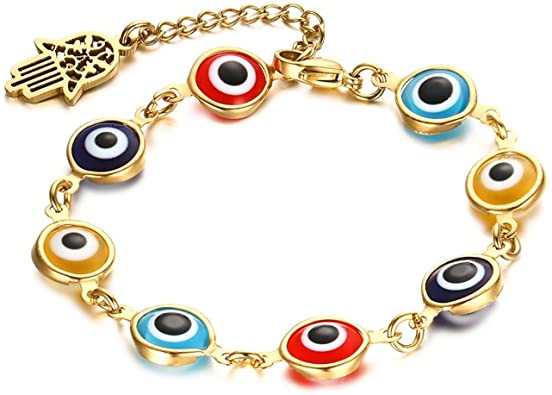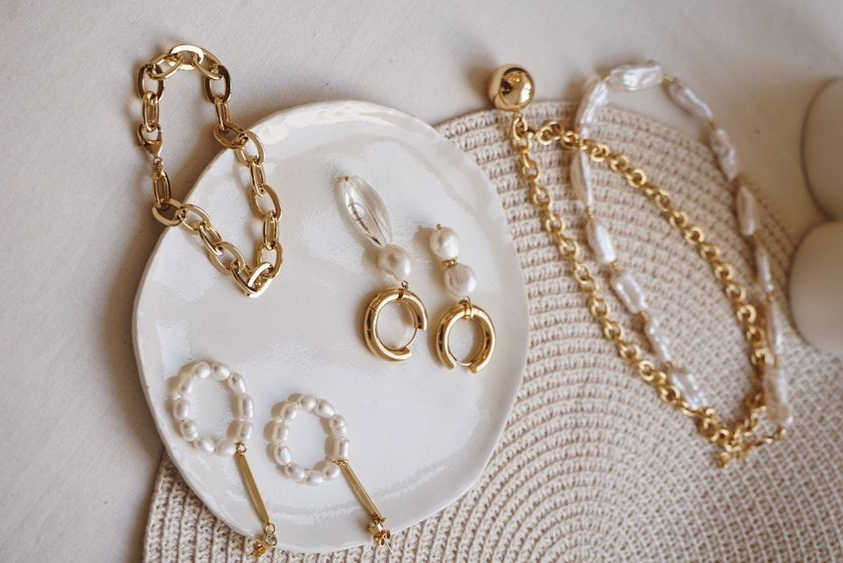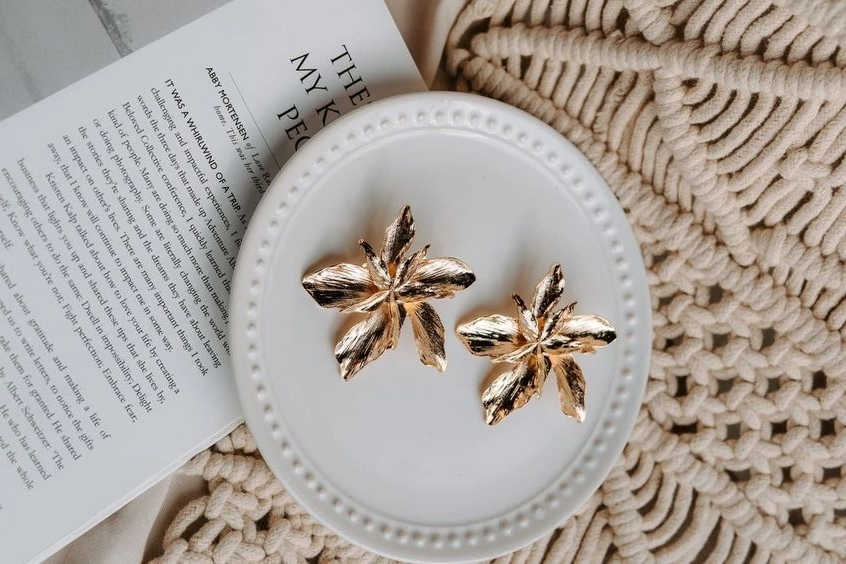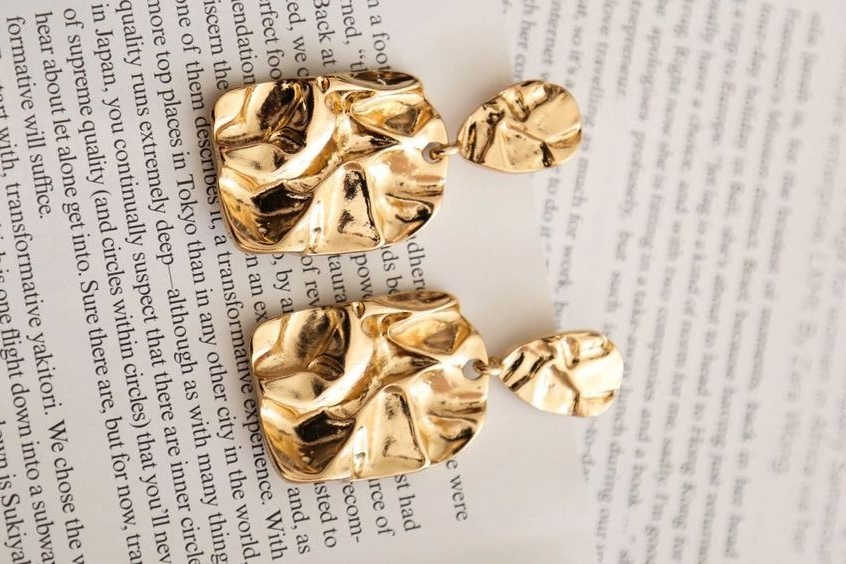Prong Setting
The prong setting is the most common and classic ring setting type. It is also referred to as a solitaire setting when a ring features a single stone. A prong is a little metal claw that holds the diamond tightly in place. Prongs can be rounded, pointed, flat or V-shaped, the latter is more common for diamond shapes with sharp edges such as the marquise, princess and pear cut.
Most prong settings feature either four or six prongs; the former allows to see more of the stone due to a minimum presence of metal, while the latter is more secure.
Pros of a Prong Setting
- Elevates the diamond, making it more noticed;
- Increases the stone’s brilliance and fire;
- Compliments all diamond shapes;
- Easy to clean and maintain;
- Offers a timeless and classic look.
Cons of a Prong Setting
- Can band and snag clothes or hair, especially if high-set;
- May become loose over time. It’s recommended to have the prongs inspected regularly.
Trellis Setting
The trellis setting is a subcategory of the classic prong setting. This style features four prongs that interwave to hold the centre stone creating an elegant and secure design. Often the trellis setting can be decorated with smaller diamonds or filigree to bring a vintage effect. The trellis design offers prominent brilliance and sparkle to the stone as it exposes the pavilion of the diamond and let the stone shine in more angles.
Pros of a Trellis Setting
- Elevates the diamond, making it more noticed;
- Increases the stone’s brilliance and fire;
- Compliments all diamond shapes;
- Offers a timeless and elegant look.
Cons of a Trellis Setting
- Can band and snag clothes or hair;
- May become loose over time;
- Requires more time with cleaning and care.
Tiffany Setting
The Tiffany setting is a variety of solitaire six-prong settings introduced by Tiffany and Co. in 1886. It is developed to maximize the brilliance of a diamond. The main feature of this setting type is the gaps where the prongs meet to expose the culet. This makes the stone appear as it is floating in place. Another prominent characteristic is the band that is kept completely free of any decorations such as milgrain or pavé so that all the emphasis is on the diamond.
While it is always possible to find a similar setting at many jewellery shops, it will never be an exact Tiffany setting because this style is trademarked.
Pros of a Tiffany Setting
- Maximizes brilliance due to the raised diamond setting;
- Compliments a variety of diamond shapes and cuts;
- Easy to clean and maintain;
- Offers a timeless and classic look.
Cons of a Tiffany Setting
- Can band and snag clothes or hair, especially if high-set;
- May become loose over time. It’s recommended having the prongs inspected regularly.
Bezel Setting
The bezel setting is the second most popular ring setting type which offers a modern and sleek look along with the highest level of security. Bezel setting encircles a diamond with a thin metal frame that holds the stone tightly in place making it suitable for an active lifestyle. A bezel setting can be full or half. A full bezel surrounds the diamond, while a half bezel leaves the sides open.
Pros of a Bezel Setting
- The most secure setting type;
- Does not band and snag clothes or hair;
- Protects the diamond preventing damages from accidental hits;
- Easy to clean and maintain;
- Offers a modern and sleek look which is perfect for minimalist rings.
Cons of a Bezel Setting
- Hides more of the stone than a prong setting;
- Has less light reflection and brilliance than a prong setting.
Tension Setting
The tension setting is named for the tension of the metal band that holds the diamond in place. In this setting type, a diamond is suspended between two sides of the shank.
To achieve the tension effect, jewellers cut tiny grooves into the sides of the shank so the diamond is held by the pressure of the custom-designed band. The level of security can be compared to the one offered by the bezel setting, though in extremely rare cases a stone may fall out if hit hard.
Pros of a Tension Setting
- Securely holds a diamond in place;
- Offers a unique and stylish appearance;
- Easy to clean and maintain.
Cons of a Tension Setting
- Difficult and expensive to resize;
- Makes small carat weight stones look even smaller;
- Has less light reflection and brilliance than a prong setting.
Channel Setting
The channel setting is used to set smaller diamonds also known as diamond accents. This setting style is popular for wedding and eternity bands as well as diamond pavé bands on engagement rings.
In a channel setting diamonds or other gemstones are set closely together into grooves of the channel which tightly hold the stones protecting them from outside forces. Since there are no prongs, the setting doesn’t band and doesn’t snag clothes or hair.
Pros of a Channel Setting
- Securely holds gemstones;
- Protects stones from outside forces;
- Enhances a ring’s sparkle;
- Doesn’t band and snag clothes or hair.
Cons of Channel Setting
- Requires more time and effort with cleaning as dirt accumulates in the channels;
- Can be hard to repair and resize due to the complex structure of the design;
- Hides diamonds more than the prong setting.
Pavé Setting
The pavé setting, pronounced “pa-vay,” comes from the French word “to pave”. It features closely set small diamonds or other gemstones with minimal visibility of the tiny metal beads or prongs which hold them in place offering the effect of continuous sparkle.
To create the pavé design, jewellers drill holes into the metal and place the diamonds into the holes. Then they form tiny beads or prongs around each diamond and secure them into the drilled holes.
Also referred to as a bead setting, the pavé style may be called a micro-pavé in case of stones weighing less than 0.01 carats.
Pros of a Pavé Setting
- Highlights the centre stone of an engagement ring;
- Enhances the ring’s overall brilliance and sparkle.
Cons of a Pavé Setting
- Can be hard to repair and resize due to the complex structure;
- There is still a risk of losing pavé diamonds especially if they are set all around the band.
Cathedral Setting
The cathedral setting is a classic style which is also one of the most elegant designs. As the name suggests, this ring setting type features arches of metal to hold the diamond similar to the arches of a cathedral.
This style describes how a diamond is mounted with arches rather than the way it is held. That is why a diamond in a cathedral setting may be set with prongs, bezel or tension setting.
Pros of a Cathedral Setting
- Accentuates and highlights the centre gemstone;
- Holds the centre stone securely;
- Can make the stone appear larger;
- Offers a unique design.
Cons of a Cathedral Setting
- Can band and snag clothes or hair if high-set;
- Requires more time and effort to clean due to many details.
Bar Setting
The bar setting is similar to the channel setting. The difference is that the channel setting enclose diamonds on all sides, while the bar setting leaves diamonds exposed on two sides held by two vertical bars of metal on the other two sides.
This style is popular for eternity and wedding bands or compliments the centre stone of an engagement ring.
Pros of a Bar Setting
- Offers better visibility to stones than the channel setting;
- Securely holds stones in place;
- Enhances sparkle and brilliance.
Cons of a Bar Setting
- Less secure than the channel setting;
- Resizing can be hard due to the complex structure;
- Higher chance of chipping the stones, as they are less protected by metal.
Flush Setting
The flush setting also referred to as a gipsy setting is a popular style for wedding bands, especially men’s wedding bands, to add character to the jewellery piece.
It features a gemstone set into a drilled hole which is then surrounded by a hammered metal to hold it in place. Since a jeweller needs to hammer the metal around the stone, this setting type is not suitable for softer gems as they can crack in the process.
The flush is a highly secure setting type that protects the stone from chipping and falling off. Like the bezel setting, this is a perfect choice for those with an active lifestyle.
Pros of a Flush Setting
- A highly secure setting type;
- Does not band and snag clothes or hair;
- Protects the diamond preventing damages from accidental hits;
- Easy to clean and maintain;
- Offers a modern and sleek look.
Cons of a Flush Setting
- Hides more of the stone than other ring setting types;
- Limits the light reflection and brilliance of a stone;
- Less likely to catch attention.
Invisible Setting
The invisible setting features diamonds or other gemstones tightly placed next to each other so that there is no prong or bezel in between them. The stones are held in place due to the metal structure that is underneath the gems.
This setting type is usually associated with vintage or antique rings because it was extremely popular during the Art Deco period in the 1920s.
Although the stones in this design show off nicely, it is not among the most secure ring setting types and there is a higher risk of losing your stone.
Pros of an Invisible Setting
Does not band and snag clothes or hair;
Provides an opportunity for personalization and colour contrast;
Offers a vintage or antique look.
Cons of an Invisible Setting
Less secure than other setting types;
Limits the light reflection and brilliance of stones;
Requires more time and effort to clean due to many details.
Halo Setting
Halo is a type of engagement ring setting that is designed with a central gemstone surrounded by a circle of pavé or micro-pavé stones, usually diamonds. The name halo rather describes the surrounding stones than the way diamonds are set.
The halo setting makes the centre stone appear larger due to the extra amount of brilliance provided by pavé diamonds. This design comes in various shapes to mimic the centre stone outline or to add some contrast. For the extra sparkly effect, halo engagement rings often feature diamond pavé bands.
This is a great option to save money on a smaller diamond while not sacrificing the overall appearance of the ring.
Pros of a Halo Setting
- Quarter, third or half-carat diamonds can look as much as half a carat larger;
- Enhances the brilliance of the centre stone;
- Protects the centre stone from side hits;
- Compliments all diamond shapes and cuts.
Cons of a Halo Setting
- High-carat centre diamond looks enormous in a halo setting;
- Smaller stones in the halo may become loose and fall out over time;
- If the halo ring features a pavé band, resizing can be difficult;
- Requires more time and effort to clean due to many details.
Three-Stone Setting
As the name suggests, the three-stone setting features three gemstones set closely together. The stones can either be of the same size or the centre stone can be larger than the two side stones.
The gemstones in a three-stone ring can be set in a number of ways, from the classic prong to the modern bezel.
To add more contrast, a three-stone setting can be personalized with coloured gemstones.
Pros of a Three-Stone Setting
- Maximizes overall sparkle and brilliance;
- Allows multiple large gemstones;
- Enhances the appearance of the centre stone;
- Can be personalized with coloured gemstones.
Cons of a Three-Stone Setting
- Requires more time and effort to clean than a single stone ring.
Cluster Setting
A cluster setting features smaller diamonds or other gemstones tightly set together to look like a large stone. This setting type can either contain stones of the same size or a larger centre stone surrounded by smaller gems.
Gems in a cluster design can be set by prongs, bezels and others, so the name of this setting describes the way the stones are grouped rather than the way they are set.
Although this design is a little rarer to find nowadays, it is still a graceful way to set your diamonds to give your ring a vintage vibe.
Pros of a Cluster Setting
- Creates an illusion of a large gemstone;
- Enhances overall brilliance and sparkle;
- Provides a lower cost option;
- Offers a vintage look.
Cons of a Cluster Setting
- Can bend and snag clothes or hair;
- Requires more time and effort to clean due to many details.
Illusion Setting
As the name suggests, the illusion setting creates the illusion of a bigger diamond. This effect is achieved by adding a ring of metal around the girdle of the stone.
The shape of the metal ring mimics the shape of the stone which makes it look larger than it is. The illusion setting features the same idea as the halo setting but without smaller diamonds around the centre stone.
This style describes how a diamond is mounted as the stone is held by prongs and features nearly the same advantages and disadvantages as the prong setting type.
Pros of an Illusion Setting
Elevates the diamond, making it look bigger;
Increases the stone’s brilliance and fire;
Compliments all diamond shapes;
Offers a vintage look.
Cons of an Illusion Setting
Can band and snag clothes or hair, especially if high-set;
May become loose over time. It’s recommended to have the prongs inspected regularly.
Requires more time with cleaning and care.
Ten articles before and after
Prong Setting Vs Bezel Setting Rings Which one is Better?
Why Choose the Wood Inlay Men’s Wedding Ring?
9 Ring Settings You Need To Know Before You Purchase Rings
When And How To Make The Ring Smaller Without Changing Its Size?
10 Popular Temporary Ring Size Adjusters
How to clean and protect Gold Plated and Silver Plated?
4 Ways To Keep Jewelry From Tarnishing




